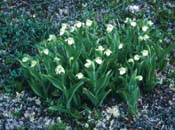Current studies
Mingan Archipelago National Park Reserve
Current Studies
- The Plants of Interest Management Plan
- Monitoring Plants of Interest
- A Study on the Snowshoe Hare and Traditional Snaring Activities
- Marine Avifauna Management Plan
- The Park's Ecological Integrity Statement
- Digitalization of the Park's Territory

Shy Wallflower
© Parks Canada / J. Audet / G 41 01 26 , 1988
The Plants of Interest Management Plan
A certain number of the 450 species of vascular plants in the Mingan Archipelago National Park Reserve of Canada ( MANPRC ) have been accorded the status of "plants of interest". One of the means employed by the park to protect these species is the Plants of Interest Management Plan.
This undertaking involved drawing up a list of plants of interest, identifying the principal concerns and determining the appropriate management measures. An analysis produced a list of 103 species of plants of interest in the archipelago. The criteria used to produce this list were as follows:
- Geographic rarity
- Colony size
- Vulnerability to trampling
- Habitat(s) where the species is present
- Stability or fragility of the habitat
- Habitat representation in the archipelago
- Designation by the Ministère de l'Environnement du Québec
- Designation by COSEWIC (Committee on the Status of Endangered Wildlife in Canada)
In addition to the list, the principal threats to the plants were identified. Among the concerns for plants of interest are the following:
- Development of the park
- Human activities
- Small size populations
- Natural agents of disturbance (fire, windfall, rock fall, seabirds, insect pests, etc.)
- Exotic species introduced into the park
- Grazing
- Pollution
- Harvesting
Among the above, our most significant concerns are development of the park and human activities.
Measures implemented to protect these fragile species from the threats identified above include visitor awareness programs, population monitoring, the closure of certain sections of the park, tourism activity management, scientific research, and the environmental assessment for the new projects.
Management plans are continually updated to better reflect the changing realities of the environment. Data analysis, as well as periodic evaluations of the impact of each measure, thus give way to recommendations aimed at protecting plants of interest and their habitats.
Monitoring Plants of Interest

Sparrow's-egg Lady's slippers
© Parks Canada / M. Boulianne / G 117 05 33 , 1989
Several colonies of plants of interest were monitored from 1993 to 1995. In 1999, a more complete monitoring program with longer-term objectives was introduced. The on-going goal is to implement a permanent method of detecting changes in the distribution and abundance of these plants by according particular attention to those most susceptible to threats. The data gathered will indicate the state of the colonies' health and will allow more specific monitoring programs in areas where problems have been detected.
The monitoring of plants of interest continues from year to year. Frequency and methods used vary according to a species' rank in the list of plants of interest, the type of threat it faces and the number and size of its colonies in the archipelago.
A Study on the Snowshoe Hare and Traditional Snaring Activities
Since its creation in 1984, the Mingan Archipelago National Park Reserve of Canada ( MANPRC ) has yielded little information on medium-sized mammals such as the Snowshoe Hare ( Lepus americanus ), the Red Fox ( Vulpes vulpes ) or the American Marten ( Martes americana ). A study on small mammals describes this micro-fauna, and draws a preliminary picture of the distribution of other mammals. In addition, knowledge of traditional practices has been gathered over the years by local inhabitants of the Mingan region. However, no study was ever carried out specifically on the hare.
Following local community demands in 1999, the National Parks Act was recently amended to allow residents of the region to carry out certain traditional activities such as Snowshoe Hare snaring. A regulation is currently under approbation.

Snowshoe Hare
© Parks Canada / M. Boulianne / M 01 57
In this context, studies on the snowshoe hare and on snaring activity are necessary in order to better understand the hare's ecology in the MANPRC , to ensure the species' conservation over time and to favour the continuation of snaring activities by residents of the Mingan region.
As of autumn 2001, a study is under way in collaboration with the Association de Chasse et Pêche de Havre-Saint-Pierre, the Université de Québec à Rimouski ( UQAR ) and Parks Canada, along with the participation of Mingan region residents.
The study is being conducted over a 5-year period and is taking place on 10 experimental sites on the islands and 2 sites on the mainland. Data gathered on snaring as well as population monitoring and leveret production inventories will show whether or not hare populations on each of the islands are stable, rising or in decline.
In addition, an inventory on grazing carried out at the beginning of the study will allow the hares' feeding patterns, availability of food and impact on the vegetation to be measured. The species' subjection to cyclical variations of abundance on an island milieu can also be determined.
Mr. Jean Ferron, Professor of Biology at the UQAR , is the acting Science Advisor and will provide recommendations on hare population management and hare snaring activities once the data have been collated. A Master's student, Mr. Marc-André Roy, will carry out the research.
Marine Avifauna Management Plan

Atlantic Puffins and Razorbills
© Parks Canada / É. Le Bel / L 31 04 73, 1996
Consisting of 12 species and nearly 35,000 nesting couples, the marine avifauna of the Mingan Archipelago National Park Reserve of Canada ( MANPRC ) plays an important role in the social, tourism and environmental aspects of the Mingan region. However, the seabirds of the MANPRC remain vulnerable to numerous stress factors in the region (disturbance, development, poaching, oil spills, etc.). Since 1984, a seabird monitoring program in the MANPRC has been carried out by Parks Canada, as well as the five-year migratory bird inventories conducted by the Canadian Wildlife Service. However, the knowledge acquired, follow-up programs and management measures all need to be placed within the framework of a cohesive management plan in order to ensure the protection of seabird populations.
Drafting of a MANPRC marine avifauna management plan was initiated by Parks Canada in 2000, in the interests of directing conservation actions and acquiring data. The plan treats different themes, particularly the synthesis of knowledge on different species as well as monitoring programs, management measures, research needs, collaboration with other organizations and the terms of use of this resource.
The Park's Ecological Integrity Statement
Parks Canada is legally bound to preserve the ecological integrity of its parks through management practices that are centred on the ecosystems. The National Business Plan for Parks Canada has called for the preparation of benchmark statements on ecological integrity. These Ecological Integrity Statements ( EIS ) form the framework used to provide direction in the management planning process of a national park. They are an integral part of the park's management plan as well as its business plan.
The drafting of an ecological integrity statement for the Mingan Archipelago National Park Reserve of Canada ( MANPRC ) has been under way since 2001. The park's EIS aims to present the values of the ecosystems, enumerate the stress factors affecting them and describe the conditions guaranteeing their maintenance and natural evolution. This document confirms Parks Canada's obligations regarding the protection of the MANPRC ecosystems while keeping in mind the human values associated with this environment. The EIS is addressed to all those implicated in the protection, management and presentation of the MANPRC . The document should be available by the end of 2002.
Digitalization of the Park's Territory

Digitalization of the Park's Territory
© Parks Canada / B. Roberge, 2001
The Mingan Archipelago National Park Reserve of Canada ( MANPRC ) contains some 2000 islands and islets, many of which have yet to be precisely identified and rendered in a computerized format. Identification and digitalization of the entire MANPRC territory will create a reliable system of reference, which will in turn enable accurate mapping and yield a store of information on the park's natural resources and their management, monitoring and protection.
This need is even more apparent seen in the context of the park's management plan review, particularly regarding the currently non-existent zoning, protection and presentation of the park's eastern sector. Within the framework of this project, islands and islets were positioned using a DGPS (Differential Global Positioning System) during the summer of 2001. The project will resume in 2002.
Related links
- Date modified :